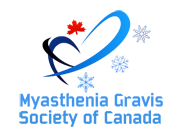How is Myasthenia Gravis Diagnosed?
If any of the symptoms point to a possibility of MG, the physician in charge many use some of the following tests or procedures:
Laboratory Tests
A blood sample is taken and analysed for the presence of AChR (Acetylcholine receptor), MuSK (Muscle-specific kinase) or rarely LRP4 or Agrin antibodies. Their presence indicates you almost certainly have MG but these antibodies are not found in all patients with MG (‘Seronegative’).
Neurological Exam
This examination tests to see how the nerves and muscles react to certain stimulation. The focus is both on how well and how long you can perform certain tasks with your muscles.
Tensilon™ Test
The drug Tensilon™ is injected into a vein. If your strength improves temporarily it is a sign that you may have MG. However, this test is rarely done these days.
Ice Pack Test
The local application of ice over a droopy eyelid will sometimes produce temporary improvement for a few minutes after the ice is removed. This test has mostly replaced the Tensilon Test.
Pulmonary Functions Tests
Pulmonary function or breathing tests help the doctor determine whether or not your respiratory muscles are affected.
Electromyography
Electromyography (EMG) is a test for determining how well the muscles respond to electrical stimulation. Several muscles may need to be tested. Although sometimes a little uncomfortable, this test provides valuable information. Two tests are used specifically to diagnose MG; repetitive nerve stimulation (RNS) and single fibre EMG (SFEMG).
Disclaimer
Information in the Myasthenia Gravis Society of Canada Website expresses the views of the author and are for information only, not medical advice. All patients should consult with their physicians for medical treatment.
